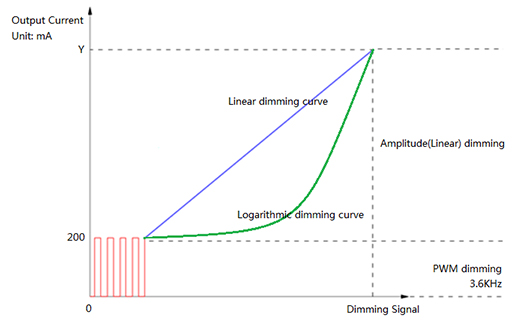The Basics of 0.1% Deeply Dimmable LED Driver
1. Parameters of Dimmable LED Drivers
As long as we mentioned dimmable LED driver, someone will have a deep impassion on filament lamps dim, also known as phase cut dimming or TRIAC dimming. The system relies on reducing the voltage that reaches the LED fixture, typically by ‘chopping-out’ parts of the alternating voltage. More phase cut, lower input voltage, and meant a lower light output. You can see it in the figure1. However, this dimming type is inefficient on energy-saving and cause harmonic wave pollution in electrical grid. Contrast with traditional dimmable system, the newer digital dimming system have been developed accompany with updated LED technology for few years. There are thousands of different dimmable LED light fixtures on the market, but only three major types of innovated dimming method: 0-10V(Transfer analog signal to inner digital signal to control light out), DALI or DMX. The lighting fixture adopt those innovated dimming method have many advantages compare with phase cut dimming. There are more efficient, less harmonic wave pollution and higher performance in dimming application. The three primary lighting objectives when considering dimming are that it be smooth, deep, and has a low risk of visible distractions or physiological effects of flicker through the dimming range. MOONS' 0.1% deep dimming function is designed to achieving natural dimming performance. As a common consumer, we should have a concern about those three aspects before you choose a dimmable LED driver. Figure1. TRIAC Dimming (From de.wikipedia)
Figure1. TRIAC Dimming (From de.wikipedia) 1.1 Smoothness of Light Output
To achieving the smoothness of light output, we should understand it depend on the distinction from one dimming level to other dimming level. You can see the figure 2 as shown in below. To ensure natural dimming performance the driver should step the LED from 100% light output to its low end light level without perceived change. Figure 2. Dimming Step vs. Smoothness of Light Output
Figure 2. Dimming Step vs. Smoothness of Light Output 1.2 Light Level
Figure 3 shows the relationship of measured light versus perceived light (blue line). This is an important distinction to make with LEDs since achieving low stable light levels is often a challenge. With traditional incandescent and halogen sources this was not an issue because they were able to dim smoothly to very low perceived light levels. Figure 3. Measured Light vs. Perceived Light
Figure 3. Measured Light vs. Perceived Light 1.3 Flicker
A major issue plaguing the LED dimmable lighting industry today is flicker but not simply flicker that is easily perceived. The Illuminating Engineering Society of North America (IESNA) Lighting Handbook defines it as the "rapid variation in light source intensity" (Rea, 2000). Virtually every light source powered from an AC line will have some type of modulated signal.2. Why You Need 0.1% Deep Dimming
As we say above, there are three aspect of dimming requirement contribute to natural dimming performance. The figure 4 shows the performance of MOONS' DALI driver (0.1%-100% dimming) on mixing warm and cold color temperature LEDs.Assume there is a CCT fixture:
1. Warm White LEDs (2500K) max power=50W;
2. Cold White LEDs (6500K) max power=50W.
The relationship between dimming rang and CCT rang is shown as below table1.
-
Table 1. Dimming Rang and CCT RangDriver's Dimming Range Valid CCT Range 0%, 10%-100% 2500K, 2900K-6100K, 6500K 0%, 5%-100% 2500K, 2700K-6300K, 6500K 0%, 1%-100% 2500K, 2540K-6460K, 6500K 0%, 0.1%-100% 2500K, 2504K-6496K, 6500K  Figure 4. CCT vs. Power in Different Dimming Depth
Figure 4. CCT vs. Power in Different Dimming Depth
3. MOONS' Dimming Strategy
3.1 Hybrid Approach to Dimming
There are two primary methodologies in use for dimming LEDs: Pulse Width Modulation (PWM) and Amplitude Dimming. Each has its own advantages and disadvantages as shown below.| Pulse Width Modulation | Amplitude Dimming |
| Allows deep dimming. | Difficult to achieve deep dimming. |
| Higher flicker risk. | Lower flicker risk. |
| Typically lower cost. | Better system efficacy in some cases. |
 Figure 5. Hybrid Approach to Dimming
Figure 5. Hybrid Approach to Dimming 3.2 Micro dimmable Step
MOONS' intelligent LED driver dimming range from 0% to 100% is divided into 255 levels (level 0 to level 254). To be specific, current under the circumstance that the output between 20% and 100% only takes 59 dimming levels. In order for the light level to transition smoothly from 0% to 20% output, the control and driver must have enough steps so the eye does not perceive the change. There are two dimming curve as shown in below figure 6. Figure 6. Dimming Level vs. Output Current
Figure 6. Dimming Level vs. Output Current 


